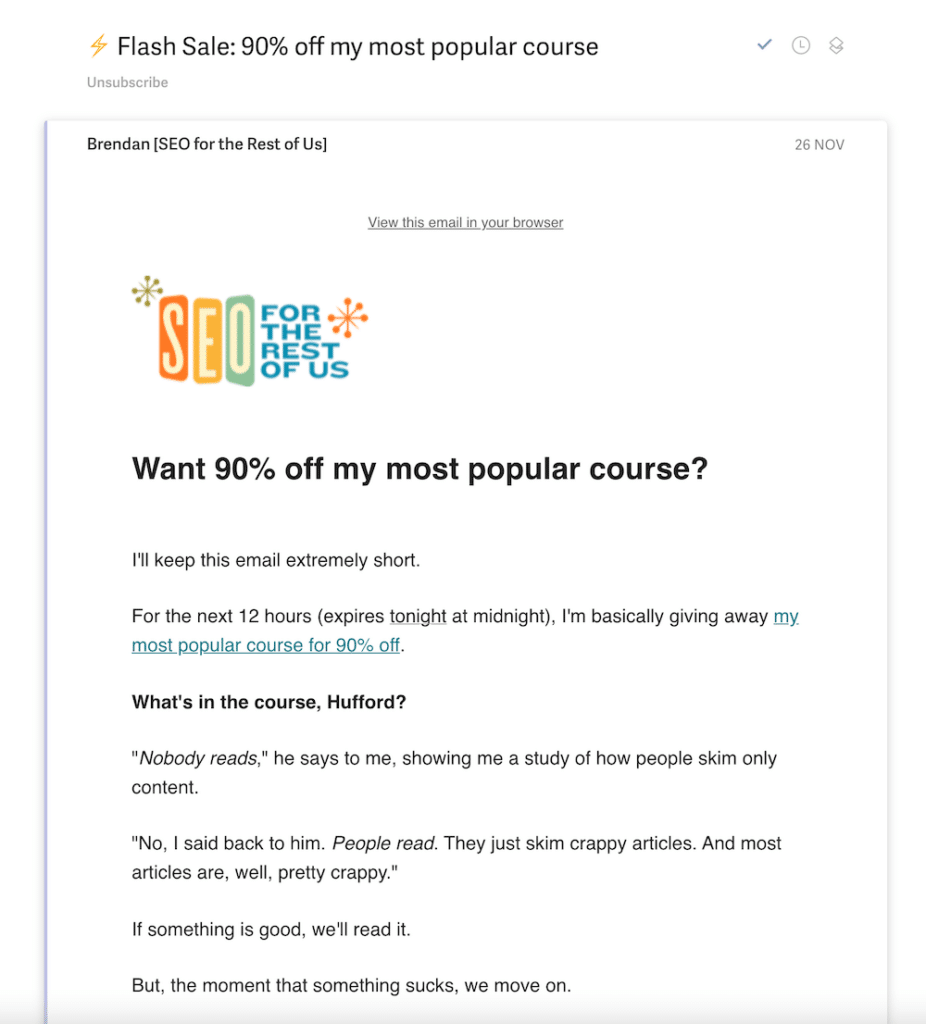When it comes to content marketing, the battle for attention is fierce. Every day, infinite pieces of content vie for the eyes and ears of your target audience, each one promising to solve their problems, answer their questions, or simply entertain them. In this crowded room, it’s not enough to merely create content – you need to create content that connects with the right people.
But how do you know which audience you’re hoping to forge a connection with? And once you do, how do you ensure that your message not only reaches them, but resonates with them enough to make them choose you over the competition? The answer lies in understanding the three distinct types of content audiences so you can tailor your approach to the one (or ones) your business needs to connect with. By doing so, you’ll be able to craft content that not only informs and engages but also drives real results for your business.
The Convinced Comparer
The Convinced Comparer is someone who knows they need a solution like yours but is still weighing their options. They’re actively researching and comparing different providers to determine which one offers the best value for their specific needs.
Scenarios where you might encounter the Convinced Comparer include:
- Highly competitive industries with multiple players offering similar products or services
- High-stakes purchases that require a significant investment of time, money, or resources
- Offerings with a complex set of features or technical specifications that need to be carefully evaluated
Creating content for the Convinced Comparer
If you’re dealing with the Convinced Comparer, your job is to show them exactly why your product or service is the best fit for their needs. This means putting your unique features, benefits, and values front and center. Take a good look at what your target audience really cares about and zero in on how your solution tackles their pain points in a way that your competitors just can’t match.
Now, the Convinced Comparer isn’t just going to take your word for it – they need cold, hard facts to make their decision. That’s where detailed product information comes in handy. Think in-depth guides, spec sheets, and comparison charts that make it a breeze for them to size up your offering against the rest. And remember, honesty is the best policy here. Be upfront about what your product can and can’t do, how much it costs, and anything else they need to know to feel good about choosing you. You know what sets you apart from the competition. Showcase these competitive differentiators in a way that make you the obvious choice.
Of course, even the most compelling facts and figures can fall flat without a little social proof to back them up. That’s why it’s so important to showcase testimonials, case studies, and third-party reviews that show the Convinced Comparer that your product delivers on its promises. By serving up a mix of both hard data and real-life success stories, you can build trust with your audience and make it a no-brainer for them to pick you over the competition.
Example: Mac Vs PC Commercials
In a stroke of comparative advertising genius, Apple released a series of clever featuring two actors, one playing a Mac and the other playing a PC, comparing their features. While the tone of the ad stays funny and conversational, it showcases exactly what sets Mac computers apart in a way that future customers with any level of technological prowess can appreciate. Nearly 20 years later, the simplicity and effectiveness of these commercials still hold up.
The Unaware Observer
The Unaware Observer doesn’t even know they have a problem that needs solving. They’re not actively searching for a solution because they haven’t yet identified the need or opportunity.
Scenarios where you might encounter the Unaware Observer include:
- Emerging markets or customer segments that haven’t been fully tapped
- Innovative or disruptive products that address a previously unrecognized need
- Latent pain points or inefficiencies that people have grown accustomed to
Creating content for the Unaware Observer
When you’re trying to reach the Unaware Observer, your mission is to open their eyes and get them excited about the possibilities. That means whipping up content that helps them see a problem they didn’t even know they had, and then showing them how your solution can lead to a brighter future. Instead of getting lost in the weeds of technical specs and product features, paint a big, bold picture of how your offering can make a real difference in their lives.
If you want to forge a genuine connection with the Unaware Observer, you’ve got to focus on the “why” behind your solution. Sure, you could rattle off a list of your product’s bells and whistles, but that’s not going to get their hearts racing. Instead, zero in on the benefits and outcomes that your offering can deliver. Help your audience see how your product or service can make their lives simpler, smoother, or just plain better. By shifting the spotlight from the “what” to the “why,” you’ll craft a message that truly hits home with the Unaware Observer.
And hey, never underestimate the power of a good story when it comes to reeling in the Unaware Observer. Share real-life examples and relatable tales that showcase the impact of the problem you’re tackling and the transformative potential of your solution. Sprinkle in some case studies, testimonials, and personal anecdotes to give your message some extra oomph and make it easier for folks to wrap their heads around. By weaving a compelling narrative through your content, you’ll forge an emotional bond with your audience and inspire them to take action, even if they weren’t originally on the hunt for a solution.
Example: Sheertex’s Unbreakable Tights
Anyone who’s worn tights knows the painful inevitability of runs and rips. Sheertex disrupted the notion that this needs to be the fate of every pair of pantyhose. They consistently run ads on social media with funny, relatable videos showing all the ways you can try to rip their tights to no avail. While many who come across these videos may not have been previously looking for tights, Sheertex’s quality content and heavy investment in advertising serves as that “Aha!” moment when you realize one of life’s little inconveniences finally has a solution.
The Procrastinating Purchaser
The Procrastinating Purchaser knows they need a solution like yours but keeps putting off the decision. They may not feel a sense of urgency or view the purchase as a top priority, even though they stand to benefit from taking action.
Scenarios where you might encounter the Procrastinating Purchaser include:
- Products or services with long sales cycles or complex decision-making processes
- Offerings that address important but not urgent needs, like retirement planning or preventative healthcare
- Purchases that require a significant change in behavior or mindset, like adopting a new software platform or embarking on a fitness journey
Creating content for the Procrastinating Purchaser
If you’re dealing with the Procrastinating Purchaser, your job is to light a fire under them and get them moving. One way to do that is by creating a sense of urgency in your content. Shine a spotlight on what they stand to lose by dragging their feet, and play up all the awesome benefits they could be enjoying if they took action pronto. Make them feel like they’re missing out on something big by hitting the snooze button on your solution.
Of course, the Procrastinating Purchaser might be putting off a decision because they’re feeling overwhelmed or unsure of where to start. That’s where a clear, easy-to-follow roadmap can work wonders. Break down the decision-making process into bite-sized, manageable steps that won’t make their eyes glaze over. And while you’re at it, offer some resources to guide them along the way, so they never feel lost or confused. The idea is to make the whole thing feel like a cakewalk, not a slog.
Finally, if you really want to give the Procrastinating Purchaser that extra nudge, consider sweetening the pot with some incentives. We’re talking limited-time promos, exclusive bonuses, or even risk-free trials that make it a no-brainer to give your solution a chance. By offering a little something extra, you’ll make them feel like they’re getting a special deal that’s just too good to pass up.
Example: SEO For the Rest of Us’s Limited Time Offer
SEO For the Rest of Us, a company offering classes in how to master SEO, sent out this short and to-the-point email blast to create urgency in potential students. Not only is the email personal and quippy, it offers a pretty unbeatable incentive (90% off) right there in the subject line, and it gives people only 12 hours to act. For someone who’s been putting off their SEO learning journey, this little push can be just the thing that gets the ball rolling.
Mastering the art of audience-tailored content
To figure out which type of content audience you’re dealing with, you’ll need to roll up your sleeves and do some research. Start by diving into your analytics and looking for patterns in how people are interacting with your existing content. Are they spending a lot of time comparing your features and pricing to your competitors’? They might be Convinced Comparers. Are they bouncing off your site quickly without engaging? They could be Unaware Observers. Do they keep returning to your content and engaging without converting? They could be Procrastinating Purchasers.
Next, take a look at your customer data and try to identify common characteristics and behaviors among your most engaged users. Are they typically at a certain stage in the buying journey? Do they have specific pain points or challenges in common? For instance, if your most engaged customers get stuck on the consideration stage, they may be a Convinced Comparer. On the other hand, if your customers mention specific long-standing challenges that your product addresses, they may be Procrastinating Purchasers. Use this info to create detailed buyer personas that capture the essence of people from your target audience that converted into customers.
Once you have a clear picture of who your audiences are, it’s time to start mapping out their unique needs and preferences. What kind of content are they looking for at each stage of the buyer’s journey? What questions do they need answered before they’re ready to make a purchase? Use this insight to create a content strategy that speaks directly to your audience’s specific needs and motivations.
Finally, don’t forget to set clear, measurable goals for your target audience so you can track your progress and make data-driven decisions about where to focus your efforts. Whether it’s increasing engagement rates, generating more leads, or improving customer retention, having specific KPIs in mind will help you stay focused and accountable as you create and optimize your content over time.
The golden triangle of content audiences
At the end of the day, creating content that truly speaks to your audience is all about understanding who they are and what makes them tick. Whether you’re dealing with the Convinced Comparer, the Unaware Observer, or the Procrastinating Purchaser, the key is to put yourself in their shoes and craft your message accordingly.
But here’s the thing – it’s not a one-and-done deal. Effective content creation is an ongoing process of learning, experimenting, and refining. It’s about staying curious, staying flexible, and staying committed to serving your audience’s needs above all else.
So don’t get too hung up on getting it perfect right out of the gate. The most important thing is to start somewhere and keep pushing forward. Keep listening to your audience, keep trying new things, and keep striving to create content that truly resonates.


